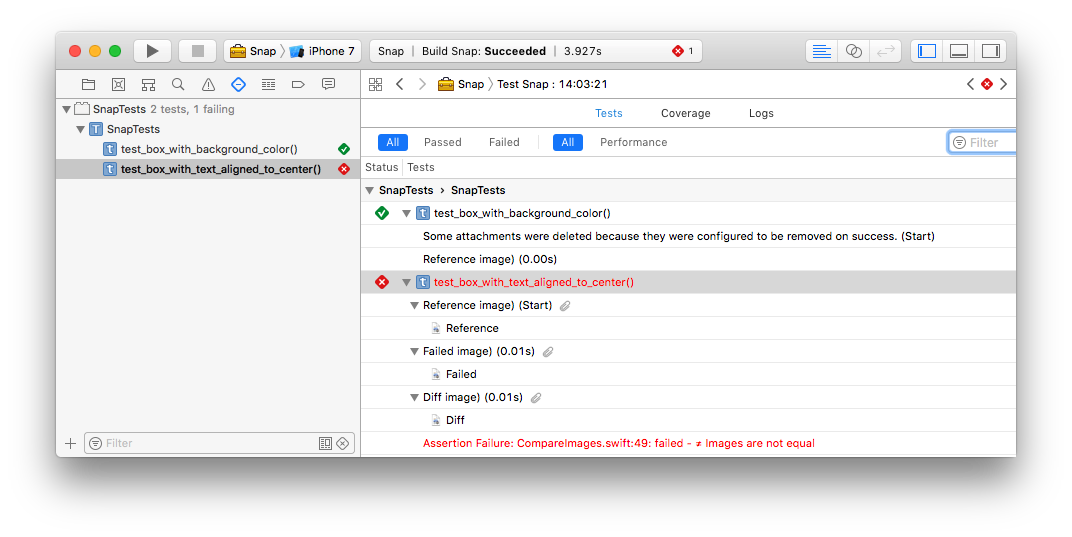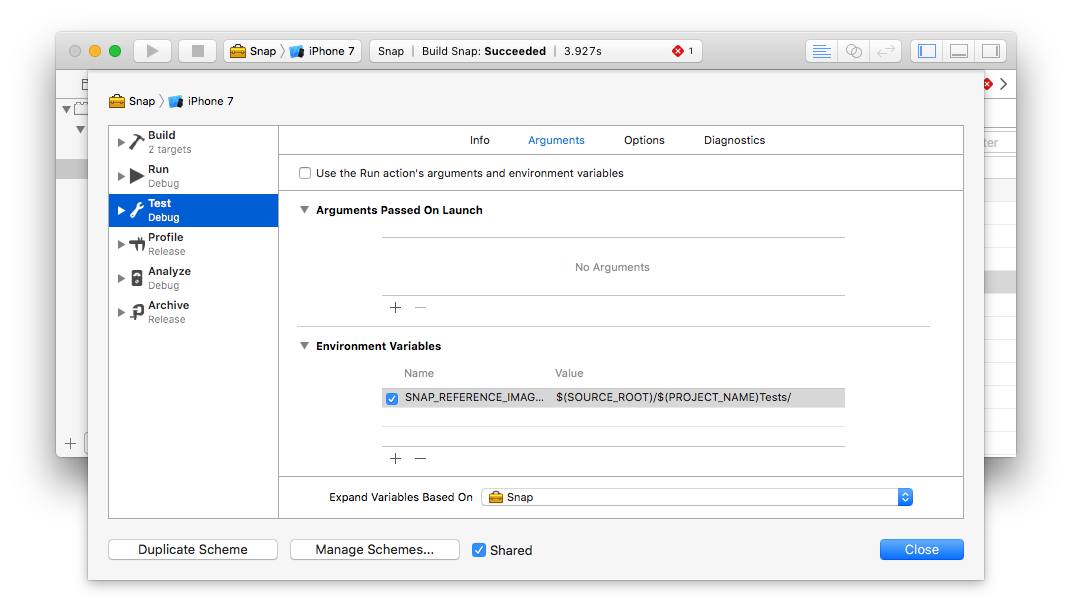Snap.swift is a snapshot testing library to facilitate the UI testing of your views.
- iOS 9.0+
- tvOS 10.0+
- Xcode 9.0+
- Swift / Objective-C
You want to make sure that every time you touch any of your UI elements everything stays as they way they were meant to be, also this kind of integration test help you achieve the pixel perfect views and make your designers happy by having design reference images that they can see even in your pull requests.
Works by generating a reference image that gets stored in your repository and then comparing each new test case with the reference image to check if there are any differences. If test found any differences it will add an attachment into your test case and you'll be able to check what changed
In order to configure the snapshot test folder, we need to add a new environment variable to the project with name SNAP_REFERENCE_IMAGE_PATH and value $(SOURCE_ROOT)/$(PROJECT_NAME)Tests/ so Snap.swift can find the folder to store the reference images.
It is also very important that the "Shared" checkbox at the very bottom is activated, so those settings are tracked in your repo and shared with your team.
If the configuration was correctly set the project should look like this:
Errored images and diffed one's are stored into
$PATH/Snap/Failedand$PATH/Snap/Diff, if you want you can add those paths into.gitignoreas these are not needed forSnap.swiftto work.
Snap.swift is available through CocoaPods. To install it, simply add the following line to your Podfile:
pod 'Snap.swift'To install with Carthage add the following line to your Cartfile:
github "skyweb07/Snap.swift"
- We first need to record our reference images, in order to do so we have to first go into our test class and set the
isRecordingvariable to betrueso the library knows that we are in record mode and can extract thereference images
Swift
import XCTest
import Snap
class SnapTests: XCTestCase {
override func setUp() {
super.setUp()
isRecording = true
}
func test_box_with_text_aligned_to_center() {
let view = BoxWithTextAlignedToCenterView()
expect(view).toMatchSnapshot()
}
}Objective-c
@import XCTest;
#import <Snap/Snap-swift.h>
#import <Snap/Snap.h>
@interface SnapTests : XCTestCase
@end
@implementation SnapTests
- (void)setUp {
[super setUp];
self.isRecording = YES;
}
- (void)test_box_with_text_aligned_to_center {
UIView *view = [BoxWithTextAlignedToCenterView new];
verifyView(view);
}
@end
After executing out test suite if everything was ok we should see that all of our tests failed with a warning similar to
⚠️ Test ran in record mode, reference image has been saved to $SNAP_REFERENCE_IMAGE_PATH/testcase.png, now remove `isRecording` in order to perform the snapshot comparison.
This is ok, it just means that our reference images were saved, we can inspect them in our reference image directory, we should normally add these into git so we can compare against them.
Remember to remove the
isRecordingflag after generating your reference images or you won't be able to do the image comparison
If you want to take multiple device snapshots at once it's as simple as:
expect(view).toMatchSnapshot(for devices: [.iphone4, .iphone5s]) // A list of devices
// or
expect(view).toMatchSnapshot(for: .allDevices) // All supportedAs today, you can make assertions on
UIViewandCALayerclasses.
This project is highly inspired on Facebook FBSnapshotTestCase library, it seems that they had archived the library so I started this one to continue envolving the project and continue with mobile snapshot-testing
If you want to apply the same testing technique on Android you can use Shot
MIT License
Copyright (c) 2017-Present Oscar Antonio Duran Grillo
Permission is hereby granted, free of charge, to any person obtaining a copy
of this software and associated documentation files (the "Software"), to deal
in the Software without restriction, including without limitation the rights
to use, copy, modify, merge, publish, distribute, sublicense, and/or sell
copies of the Software, and to permit persons to whom the Software is
furnished to do so, subject to the following conditions:
The above copyright notice and this permission notice shall be included in all
copies or substantial portions of the Software.
THE SOFTWARE IS PROVIDED "AS IS", WITHOUT WARRANTY OF ANY KIND, EXPRESS OR
IMPLIED, INCLUDING BUT NOT LIMITED TO THE WARRANTIES OF MERCHANTABILITY,
FITNESS FOR A PARTICULAR PURPOSE AND NONINFRINGEMENT. IN NO EVENT SHALL THE
AUTHORS OR COPYRIGHT HOLDERS BE LIABLE FOR ANY CLAIM, DAMAGES OR OTHER
LIABILITY, WHETHER IN AN ACTION OF CONTRACT, TORT OR OTHERWISE, ARISING FROM,
OUT OF OR IN CONNECTION WITH THE SOFTWARE OR THE USE OR OTHER DEALINGS IN THE
SOFTWARE.





